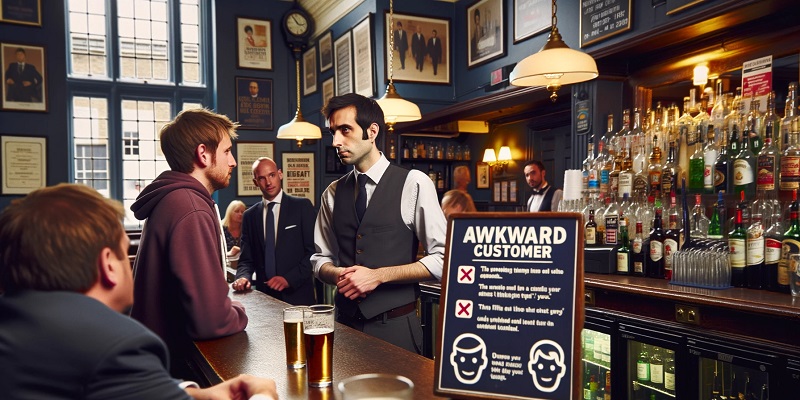🔥 Popular Free Downloads

THE FULL WORKS
All of our staff training manuals in one handy download!

FREE STAFF HANDBOOK
A totally customisable free staff handbook download.

FREE PROFIT & LOSS CALCULATOR
Keep on top of your expenses with our free profit and loss calculator.
🔥 Popular Pages
- How to Run a Restaurant
- Awesome Articles
- Managing Your Staff
- Marketing Your Restaurant
- Restaurant Financing and Funding
- Maintaining Neutrality in Pronoun Usage
- Everything You Wanted To Know About Gin
- Safe Cooking Temperatures For Meat
⭐ Popular Resources

SWOT ANALYSIS
SWOT Analysis explained in detail accompanied by a free download.

DOWNLOADS HUB
The place to download all of our free forms, templates & guides.

FREE CASH FLOW CALCULATOR
Download our free template or use our online cash flow calculator.

BAR MANAGEMENT TRAINING
Simple and free online bar and cellar management training.

Dealing With Awkward Customers
Written by The Restaurant Doctor UK Team
Last Updated: 29th October 2023
<<< 19. Licensing Act 2003 - Your Responsibilities | 21. Dealing With Theft >>>
This is the very unglamorous part of bar management, but there is a very simple set of rules to follow to help you deal with awkward customers.
First we need to decide what an awkward customer is and how they behave.
Alcohol can make people act differently so a normally quiet, well-mannered person can become irate and argumentative after a few shandies!!
We would describe an awkward customer as someone who is disturbing the peace in your bar by being loud, argumentative or disruptive.
When dealing with difficult customers, especially those who are drunk and disorderly, it's important for bar managers and staff to have a plan in place to manage the situation. Several techniques have been developed to help handle these types of situations, including CALM, IDEAL, and SAFE. These techniques provide actionable steps for managing difficult customers, and can help to promote a safe and pleasant environment for all customers. By being prepared and trained to handle difficult customers, bar managers and staff can ensure that their establishment remains a welcoming and enjoyable place for customers to visit.
CALM Technique
This stands for "Communicate, Acknowledge, Listen, and Manage." It is a method for dealing with drunk and disorderly customers by calmly communicating with them, acknowledging their concerns, listening to their complaints, and managing the situation to prevent escalation. Here are some examples of how to apply the CALM technique:
Communicate:
Use a calm and assertive tone when speaking to the customer, and try to establish a rapport with them. For example, "I understand that you're upset, but I need you to calm down so we can work through this together."
Acknowledge:
Show empathy for the customer's situation and acknowledge their concerns. For example, "I can see that you're frustrated, and I'm here to help you."
Listen:
Listen to the customer's complaints and let them express their feelings without interrupting. For example, "I'm sorry to hear that you've had a bad experience. Can you tell me more about what happened?
Manage:
Take steps to manage the situation and prevent it from escalating. This may involve offering alternative solutions or seeking help from other staff members or security personnel.
IDEAL Technique
This stands for "Identify, Diffuse, Empathize, Assess, and Limit." It is a step-by-step approach for handling aggressive or violent behavior from drunk and disorderly customers. Here are some examples of how to apply the IDEAL technique:
Identify:
Quickly assess the situation and identify any potential risks or threats. For example, "I can see that this situation is getting out of hand, and I need to take action to prevent anyone from getting hurt."
Diffuse:
Use verbal de-escalation techniques to calm the customer down and prevent the situation from escalating. For example, "I understand that you're upset, but I need you to calm down so we can work through this together.
Empathise:
Show empathy for the customer's situation and acknowledge their feelings. For example, "I'm sorry that you're upset, but I need you to behave in a manner that is safe and respectful to others."
Assess:
Evaluate the level of risk and determine the appropriate course of action. This may involve calling for backup or contacting law enforcement if necessary.
Limit:
Take steps to limit the customer's access to alcohol or remove them from the premises if necessary to ensure the safety of other customers and staff.
SAFE Technique
This stands for "Stay calm, Assess, Focus on behaviour, and Evaluate the situation." It is a method for dealing with drunk and disorderly customers that emphasizes staying calm, assessing the situation, focusing on the customer's behaviour, and evaluating the level of risk. Here are some examples of how to apply the SAFE technique:
Stay calm:
Remain calm and composed, even in the face of difficult or challenging behaviour from the customer. This can help to de-escalate the situation and prevent it from escalating.
Assess:
Quickly assess the situation and determine the level of risk involved. For example, "I need to assess the situation to determine if any action is necessary to ensure the safety of our customers and staff."
Focus on behaviour:
Focus on the customer's behaviour, rather than their personal characteristics. This can help to avoid making assumptions or stereotypes about the customer based on their appearance.
Evaluate the situation:
Continuously evaluate the situation and determine if any further action is necessary to manage the customer's behaviour and prevent it from escalating. This may involve limiting the customer's access to alcohol, calling for backup, or seeking help from other staff members or security personnel.
You may also like...
Business Finance, Credit, Borrowing Money and Funding:
Looking to borrow money or wanting to apply for a credit card, mortgage, overdraft, business loan or even car insurance for your restaurant? This article covers the areas you need to consider when applying for finance, borrowing money and applying for credit for your business. Looking after your money is important, especially money you borrow.